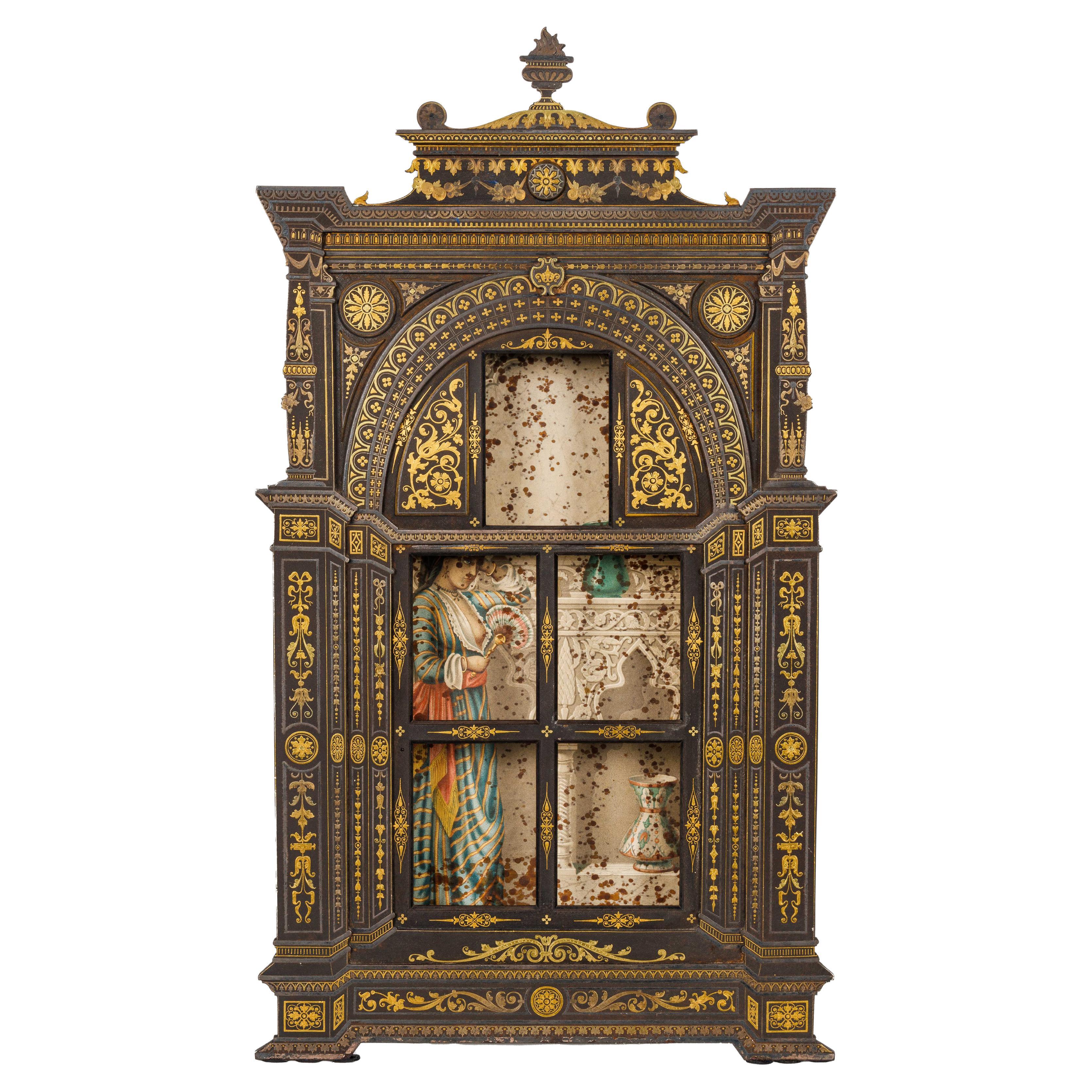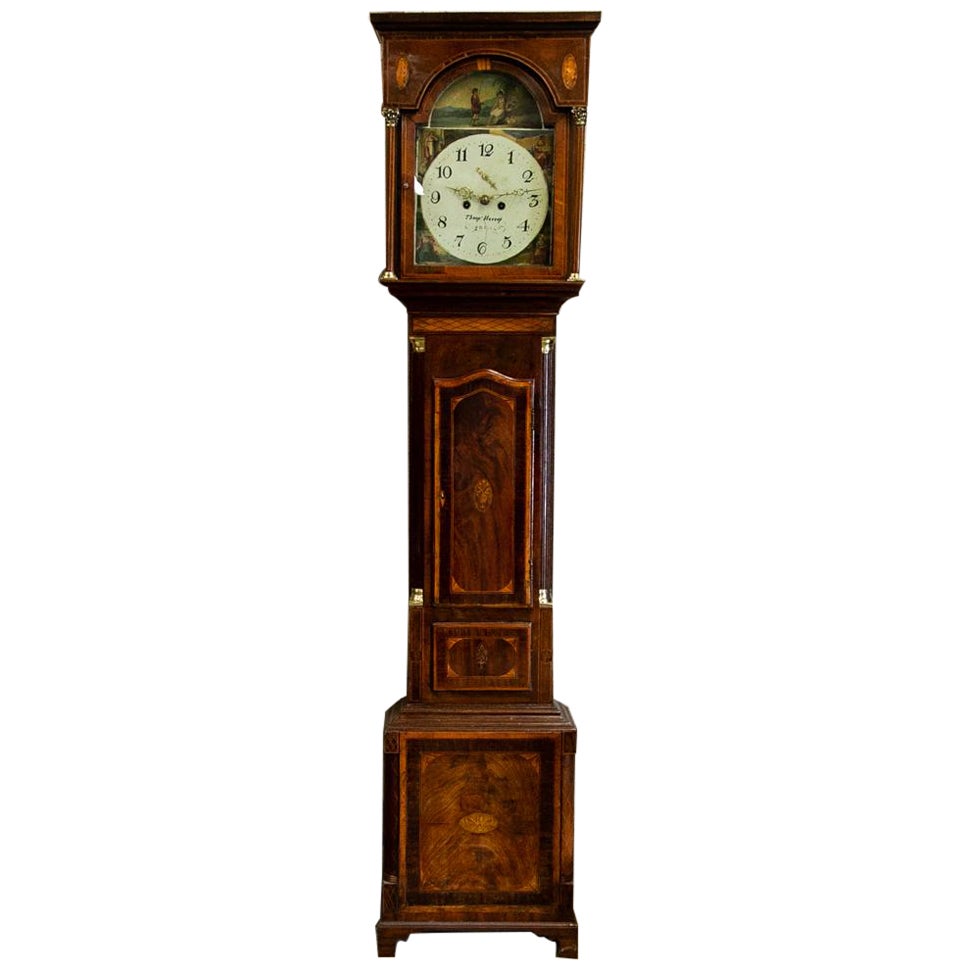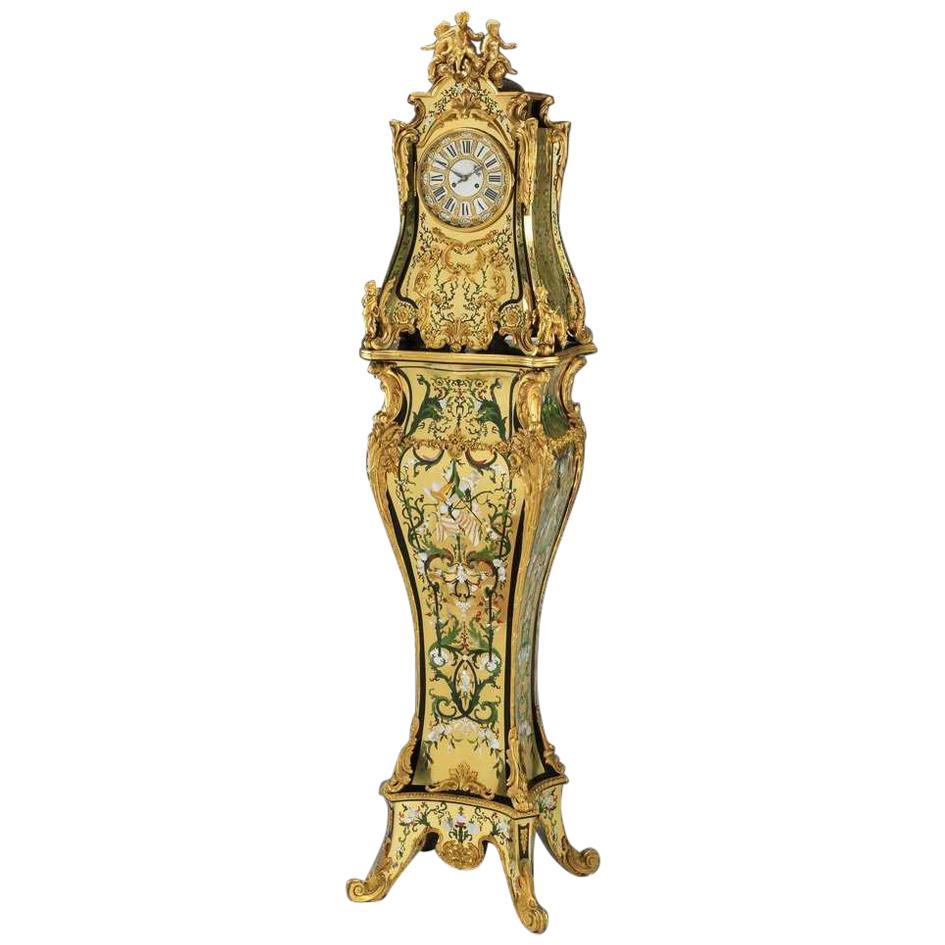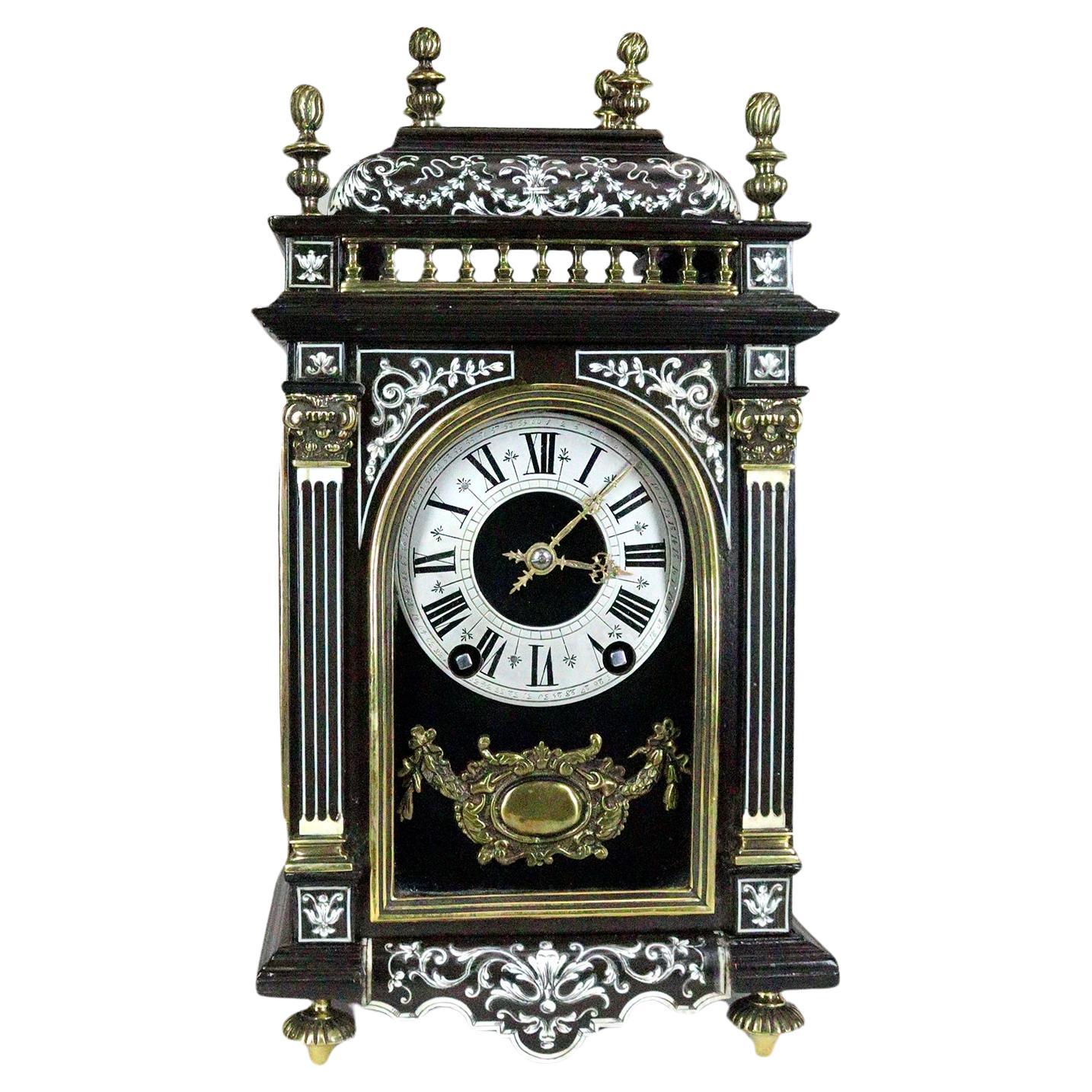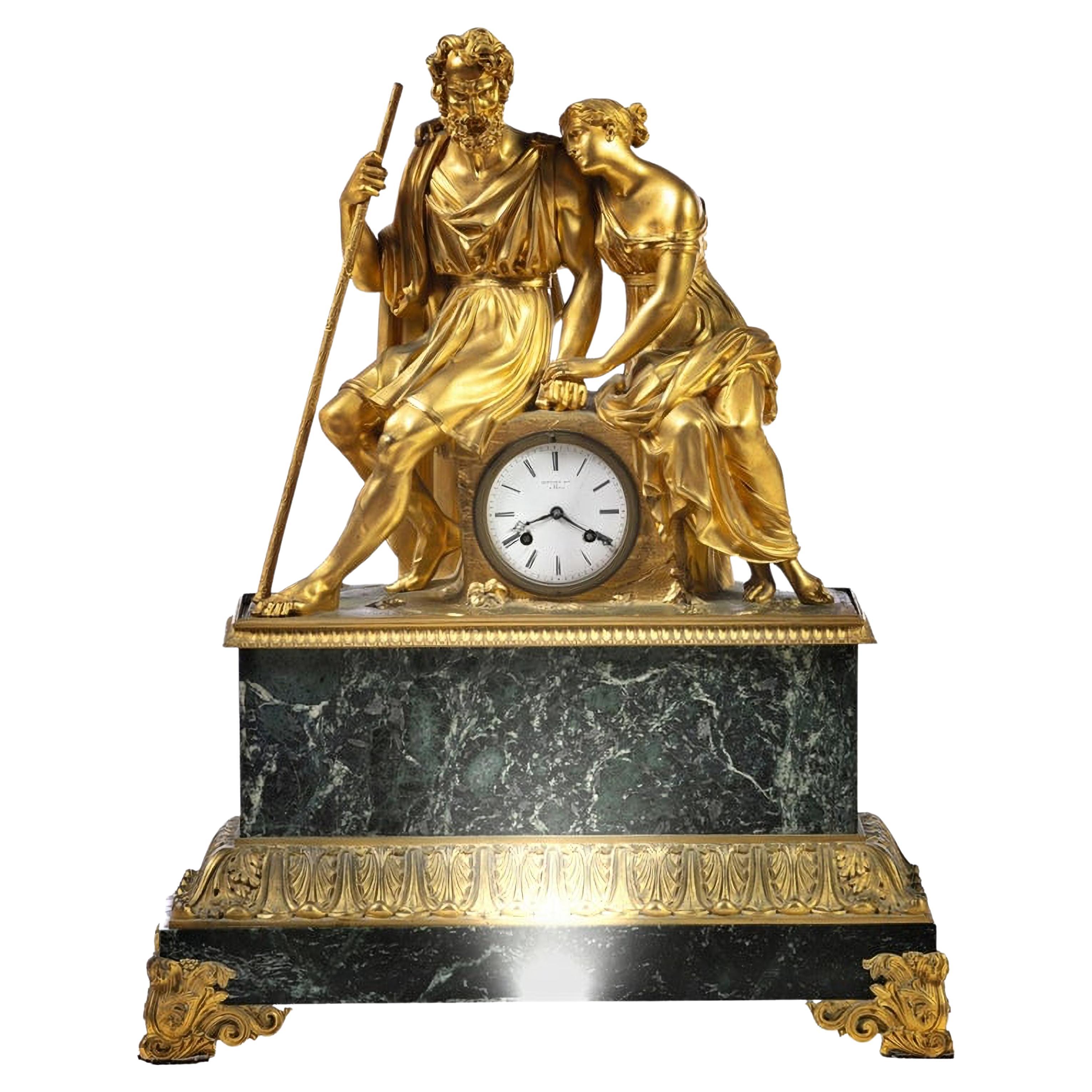Items Similar to Rare & Important Spanish Damascene, Iron, Steel, Gold Inlaid Clock, Eibar, Spain
Want more images or videos?
Request additional images or videos from the seller
1 of 21
Rare & Important Spanish Damascene, Iron, Steel, Gold Inlaid Clock, Eibar, Spain
About the Item
A highly rare and important Spanish damascene, "Egyptian Revival" iron, steel, gold, and silver inlaid clock,
circa 1900
Exceptional quality, damascened in gold and silver inlay.
Measures: 10" high x 16" wide x 9" deep.
Definitely made by one of Placido Zuloaga's disciples – such as José Vicente Iriondo or Tomás Guisasola y Guisasola, Spain, Eibar and retailed by Beristain of Barcelona, Spain.
José Vicente Iriondo, known affectionately in Eibar by the nickname ‘Mantxón’, and his brother-in-law Tomás Guisasola y Guisasola, were disciples of Plácido Zuloaga, and towards the turn of the century they became partners.
Because of the number of specialists involved in this clocks manufacture, its great size, and the excellence of its exquisite quality, one may conjecture that it was a major commission coming from a workshop manned by some of the earlier disciples of Plácido Zuloaga.
Furthermore Beristain of Barcelona are recorded to have retailed guns and other damascened works of art in the early 20th century.
Born into a family of Spanish Royal Armourers, Plácido Zuloaga (d. 1910) went on to become one of the greatest masters of the decorative art of damascening, praised in his day as 'a second Benvenuto Cellini'. His first recognition as an artist came in 1855 when, together with his father Eusebio, he inspired the following comments for work shown at the Paris Exposition Universelle: 'One cannot praise too highly the arms and other metal objects presented by the Sres. Zuloaga, father and son; iron-chiselling, damascene, etching and repoussé never had interpreters of such obvious and varied talent' (Anon. Visite à l'Exposition Universelle de Paris, Paris, 1855, p. 121).
In 1859, Plácido took over the management of Eusebio's manufactory at Eibar in the northern Basque province of Guipúzcoa, and what had principally been a gun-making factory for the previous two generations was gradually transformed under his supervision into one for forging and damascening art objects. The switch reflected not only Plácido's personal artistic interests, but also the changing face of a gun-making industry, which by the middle of the century was becoming increasingly machine-driven. Additionally, Zuloaga sought to capitalise on the midcentury fashion for iron decoration, which had its roots in architecture (for example, the pavilions constructed for the 1851 Crystal Palace Exhibition), but which was most prevalent in the form of domestic cast iron furnishings.
On the death of his father in 1856, Eusebio Zuloaga was promoted to the position of Chief Armourer to Isabel II and her consort king, and was given the title of Huntsman to the Royal Family. For the next twelve years, therefore, the firm of Zuloaga was kept busy not only supplying weaponry and armour, but also sumptuous table objects ordered by the monarchy, either for gifts or for their own private use. The latter included a gold and silver-damascened iron inkstand supplied to Isabel II in 1860 (illustrated Lavin, p. 52, fig. 10), and a magnificent table-clock ordered by the queen mother, Marìa Cristina, for presentation to Napoleon III (op. cit., p. 55, fig. 11). However, the fall of Isabel II's government in 1868 not only brought the Royal patronage enjoyed by the Zuloagas over the previous decade to an abrupt end, it left the firm with considerable monetary loss, as 30,000 francs in salary and materials for work sent to the king would now not be reimbursed. Fortunately for Plácido Zuloaga, a new patron, less prone to the precariousness of 19th century European royalty, arrived to replace the Borbóns and became his most important client for the next two decades.
Plácido Zuloaga is believed to have met Alfred Morrison during his visit to London for the International Exhibition of 1862. The son of a wealthy textile magnate, Morrison had inherited the estate of Fonthill, Wiltshire, on the death of his father in 1857. Soon after, he engaged Owen Jones, the celebrated architect, to redesign its interior to complement his already extensive collection of modern
objets d'art, commissioned from the most noteworthy European artisans of the day. Jones was an admirer of Islamic, and by extension, Spanish ornamentation, and had even spent some time living in the Alhambra, Granada. These tastes corresponded with those of Morrison, who over the next twenty years was responsible for virtually all of Plácido Zuloaga's major commissions, whether they were intended for Fonthill or for his London home at 16 Carlton House Terrace, acquired in 1865 and decorated by Jones in the same taste. Chief among these commissions were an enormous Renaissance style cassone, executed 1870-1 (sold Christie's, The Remaining Contents of Fonthill House, 1-2 November 1971, lot 9, now in the Khalili collection; see Lavin, cat. 1, pp. 71-81) and a magnificent side-table, completed in 1880 and now in the collection of Her Majesty the Queen (see Lavin, fig. 16, p. 62).
- Similar to:Plácido Zuloaga 1 (Metalworker)
- Dimensions:Height: 10 in (25.4 cm)Width: 16 in (40.64 cm)Depth: 9 in (22.86 cm)
- Style:Egyptian Revival (Of the Period)
- Materials and Techniques:
- Place of Origin:
- Period:
- Date of Manufacture:circa 1900
- Condition:
- Seller Location:New York, NY
- Reference Number:1stDibs: LU1798213687531
About the Seller
5.0
Vetted Seller
These experienced sellers undergo a comprehensive evaluation by our team of in-house experts.
Established in 1980
1stDibs seller since 2016
58 sales on 1stDibs
Typical response time: <1 hour
- ShippingRetrieving quote...Ships From: New York, NY
- Return PolicyA return for this item may be initiated within 7 days of delivery.
More From This SellerView All
- Placido Zuloaga, an Extremely Rare Spanish Gold and Silver Damascened FrameBy Plácido Zuloaga 1Located in New York, NYPlacido Zuloaga, an extremely rare Spanish gold and silver damascened window frame, circa 1880. The interior is lined and fitted with an orientalist artwork throughout. Signed PZ on the reverse. Placido Zuloaga was a renowned Spanish metalworker and damascene artist known for his exceptional skills in working with gold and silver and for creating intricate and ornate designs on metal surfaces using a technique called damascening. One of Zuloaga's works is this rare gold and silver damascened frame that he created in the late 19th century. The frame is decorated with intricate designs in silver and gold, creating a stunning contrast that is characteristic of Zuloaga's work. The frame is a remarkable example of Zuloaga's artistry and skill, as well as his mastery of the damascening technique. The technique involves inlaying silver or gold wire into the surface of the metal, creating intricate and detailed designs that are both beautiful and durable. Zuloaga's work was highly sought after during his lifetime and is still highly valued today. His pieces are considered to be some of the finest examples of damascene artistry in the world, and his legacy continues to inspire and influence metalworkers and artists today. His works are in private collections and in museums worldwide. Comparative Literature: James D. Lavin, The Art and Tradition of the Zuloagas, Spanish Damascene...Category
Antique 19th Century Spanish Islamic Picture Frames
MaterialsSteel, Iron
- Rare Important French Louis XIV Style Gilt-Bronze Mounted Boulle Marquetry ClockLocated in New York, NYA rare and important French Louis XIV style gilt bronze mounted green boulle marquetry clock, Regulateur De Parquet, with matching original pedes...Category
Antique Late 19th Century French Louis XIV Grandfather Clocks and Longca...
MaterialsBrass, Bronze
- A Rare and Exquisite French Ormolu and Porcelain Clock, attributed to DeniereBy Maison DeniereLocated in New York, NYA Rare and Exquisite French Ormolu Bronze and Porcelain Clock, attributed to Jean Francois Deniere, circa 1810. This large and elaborate clock is made of the finest quality ormolu and porcelain during the period. Of rectangular form, with porcelain and bronze columns painted with flowers and griffins, this clock would make a statement in any room. To a clock collector, this clock is a true masterpiece! Similar clocks like this, by Deniere, are in prestigious museums and collections worldwide, including the Frick Collection and the Royal Collection Trust. 21.5" high x 12" wide x 6" deep **For a similar clock see Christies New York, 21 November 2008, Lot # 139, sold for $50,000. Very good condition with no damages. All original parts. Clock is not running. More photos available upon request. Jean-François Deninger, called Denière, was one of the most illustrious bronziers of the first half of the 19th century. Appointed Envoy in Constantinople around 1796, the bronzier Denière entered into partnership with François Mathelin in 1797. They founded a prosperous operation and their atelier had over 200 workers during the Empire period - a number that subsequently doubled during the reign of Louis-Philippe. Fournisseur to the duchesse de Berry and Louis-Philippe, Denière also worked for the duke of Hamilton, Ferdinand VII of Spain, William II of Hesse, William II of Holland, Tsar Alexander II of Russia, and other heads of state. In 1817-1818 Denière furnished some of the bronze work for the redecoration of the White House in Washington. He furthermore produced the mounts for the cradle of the duc de Bordeaux in 1820 and the bronzes for Charles X's coronation coach...Category
Antique Early 19th Century French Mantel Clocks
MaterialsBronze, Ormolu
- Palatial & Rare Napoleon III French Ormolu and Patinated Bronze Clock, DetoucheBy C. DetoucheLocated in New York, NYA palatial, extremely rare, and important Napoleon III French ormolu and patinated bronze regulateur de parquet clock, by Louis-Constantin Detouche, Paris, circa 1850. The clock case made form the finest French ormolu, with 2 very large patinated bronze seated putti The white enamel dial Signed C. DETOUCHE/ PARIS. The clock movement is numbered 7064 and stamped with maker’s stamps C. Detouche RUE st. MARTIN and C. DETOUCHE 158 R. St MARTIN 160, with medaille d’argent stamp, on a serpentine part ebonized mahogany plinth. At over six feet tall, the present clock is impressive in scale and rare in Detouche’s oeuvre. While other large clocks were produced by the firm, few of this scale are so overtly decorative and usually incorporate greater mechanical complication. For example, a gilt bronze astronomical regulator clock...Category
Antique 19th Century French Napoleon III Grandfather Clocks and Longcase...
MaterialsBronze, Ormolu
- Edward F. Caldwell, An Extremely Fine and Rare Ormolu-Mounted Malachite ClockBy Edward F. Caldwell & Co.Located in New York, NYEdward F. Caldwell and Co., An extremely fine and rare American ormolu-mounted malachite clock with the prince of wales's feathers, circa early 20th century The shape, design, and...Category
Early 20th Century American Mantel Clocks
MaterialsMalachite, Bronze, Ormolu
- Exquisite French Empire Ormolu and Cut-Crystal Clock, c. 1815Located in New York, NYAn exquisite French Empire ormolu and cut-crystal clock, c. 1815, attributed to Baccarat. Made from the finest quality mercury gilding ormolu, this c...Category
Antique Early 19th Century French Empire Mantel Clocks
MaterialsCrystal, Ormolu
You May Also Like
- English Inlaid Grandfather ClockLocated in Wilson, NCThis clock is profusely inlaid with rosewood ,ebony, satinwood, and boxwood. The bonnet has two inlaid shell pateries. The center door has a classical urn inlay...Category
Antique 1790s English Grandfather Clocks and Longcase Clocks
MaterialsBrass, Steel
- A Rare and Important Charles II 17th Century Table Clock by Henry JonesBy Henry JonesLocated in Oxfordshire, United KingdomThe Rare and Important 17th Century Spring Driven Table Clock by the Celebrated Maker, Henry Jones. Provenance dating back to 1745. Owned by Captain Alexander Raitt A very rare an...Category
Antique 17th Century English Charles II Table Clocks and Desk Clocks
MaterialsBrass
- Miniature French Inlaid Religieuse ClockBy DentLocated in Amersham, GBMiniature Ebonised Religieuse or Bracket Clock originally sold by Dent. With engraved bone inlay, brass finials and balustrading. In the manner of a 17th century baroque clock with b...Category
Antique 1870s French Louis XIV Mantel Clocks
MaterialsSilver, Brass
- Important French Table Clock, 19th CenturyBy Europa AntiquesLocated in Madrid, ESImportant table clock 19th century French, in marble and relieved bronze and golden enameled dial, Roman numerals in black, eight days of autonomy, plays for hours and half hour...Category
Antique 19th Century French Napoleon III Table Clocks and Desk Clocks
MaterialsGold, Bronze
- Important Boulle Marquetry Clock, 19th CenturyBy Alfred Emmanuel Louis BeurdeleyLocated in SAINT-OUEN-SUR-SEINE, FRThis exceptional cartel presents a remarkable work of bronze and an ornamentation resuming the Boulle marquetry that can be attributed to Alfred-Emmanuel Beurdeley (1847-1919), a great Parisian cabinetmaker of the second half of the 19th century. The mechanism of our astronomical clock...Category
Antique Mid-19th Century French Louis XIV Mantel Clocks
MaterialsBronze
- Chapman Granddaughter Clock from SpainBy Chapman Manufacturing CompanyLocated in Asheville, NCThis beautiful walnut granddaughter clock made in Spain is tall and slender and will fit in any corner location.Category
Early 20th Century Spanish Baroque Clocks
MaterialsMaple
